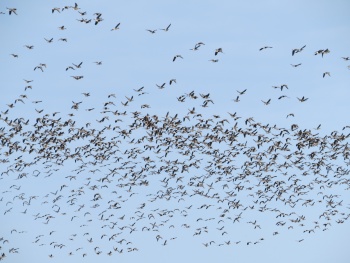
- Anser brachyrhynchus
Identiftcation
Length 60–76 cm, wingspan 135–170 cm, weight 1,800–3,300 g
- Grey body and wings
- Darker brown head and neck
- Stubby black bill with varying amounts of pink across the middle of the upper mandible
- Pink feet and legs
- Dark centre to white tail
- White undertail coverts
- In flight, pale grey forewing contrasts with darker grey-brown primaries and secondaries
Similar Species
Tundra Bean Goose is very similar structurally, but darker and browner, and with 'dayglo' orange legs and bill markings. Greylag Goose is noticeably larger, and Taiga Bean Goose slightly larger.
Distribution
Breeds in two populations, a western one in eastern Greenland and Iceland, and an eastern one on Svalbard north of Norway.
The western population leaves the breeding grounds in mid September to late October for wintering areas in Great Britain, mainly in eastern and southwestern Scotland (particularly early and late in the winter) and northern and eastern England (largest numbers in Lancashire, Northumberland, and Norfolk); rare in other parts of England, and also rare in Wales and Ireland. Return movement is mid-April to mid-May, peaking in late April.
The eastern Svalbard population leaves the breeding grounds in late August to September and passes down the coast of Norway to winter in Denmark, Germany, the Netherlands and Belgium. In severe winters some reach southeastern England and northern France. Returning birds begin to gather in Denmark in March and leave there during April-May.
Small numbers breed ferally in Britain.
Vagrants have been recorded in most European countries south to Spain, Italy and the Ukraine; also recorded in northeastern North America, on the Azores, Madeira, the Canaries and on Malta.
The Svalbard population has tripled its size since the 1960s, and the Iceland - Greenland population nearly tenfold to 360,000 birds.
Taxonomy

Photo by Nutcracker
Cresswell Pond, Northumberland, UK, February 2015
This is a monotypic species[1].
Pink-footed Goose was sometimes included in the past with Tundra Bean Goose and Taiga Bean Goose in a wider concept of Bean Goose.
Habitat
Breeds on tundra, rock outcrops or low cliffs. In winter feeds on grassland, stubble and crop fields close to estuaries, lakes and reservoirs for roosting.
Behaviour
Highly gregarious in winter, forming huge flocks of up to 60,000 or more; these making a spectacular (and deafening!) sight.
Breeding
Breeds singly or in small or large loose colonies. They nest on the ground.
Year round have been quick to discover new resources when available, such as new green winter fields due to changes in agricultural habits and they seem also to expand their breeding areas in Svalbard as temperatures are increasing.
Vocalisation
Call: wink, wink. Flocks call constantly in flight; more quiet (but not silent) when feeding.
References
- Clements, JF. 2009. The Clements Checklist of Birds of the World. 6th ed., with updates to December 2009. Ithaca: Cornell Univ. Press. ISBN 978-0801445019.
- Collins Pocket Guide to British Birds 1966
- Collins Field Guide 5th Edition
- Collins Bird Guide ISBN 0 00 219728 6
Recommended Citation
- BirdForum Opus contributors. (2024) Pink-footed Goose. In: BirdForum, the forum for wild birds and birding. Retrieved 20 April 2024 from https://www.birdforum.net/opus/Pink-footed_Goose
External Links
GSearch checked for 2020 platform.1




